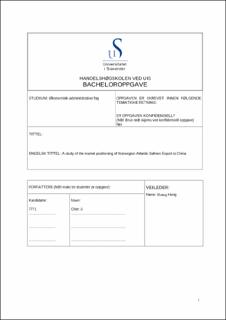| dc.description.abstract | Abstract
China is the largest seafood consumer-driven by its large population and growing middle class. However, while the demand for salmon in the country has increased, its consumption remains low compared to the country’s overall consumption of seafood and presents a huge market potential. Norwegian salmon has a competitive position, and existing studies have examined this position broadly and have not explicitly looked at its market positioning. Accordingly, this study tried to address this using a mixed methods research design involving a survey with close and open-ended questions to Norwegian salmon exporters complemented with online interview chats with Chinese consumers and secondary data from websites and other sources.
Based on the descriptive and thematic analysis of the data, the study's findings consistent with previous studies (e.g. Rakvåg & Sandøy, 2017) confirm that although Norwegian salmon has the largest market share in the Chinese market, there is potential for further growth. Specifically, the findings show that the market positioning of the Norwegian salmon follows a differentiation strategy positioning in terms of the four Ps of marketing: product, price, place, and promotion to set it as a high-quality premium pricey product targeting the Chinese middle class. However, the findings show that while this is the case, the Norwegian salmon exporters do not seem to pay enough attention to the details of the Chinese market, such as its differences between regions, lifestyles, and buying habits electronic platforms.
Consistent with the literature, the findings also show that the market positioning in terms of both product and price might be affected by macro, industry, and firm-level factors. The findings show that politics can affect the market overall. Also, there is a danger from the threat of substitutions due to imitations and new entrants where the Chinese themselves will start competing with Norwegian salmon exporters. Similarly, the findings show that strategies to support the market positioning of Norwegian salmon in the Chinese market and the factors that affect also exist at the country, industry, and firm levels. Specifically, at the country level, there is a need to promote cultural exchanges and bilateral relations. At the industry level, Norwegian exporters need more customer education and market orientation. Norwegian firms should consider partnering with Chinese firms along the value chain to cement their market position. | |
